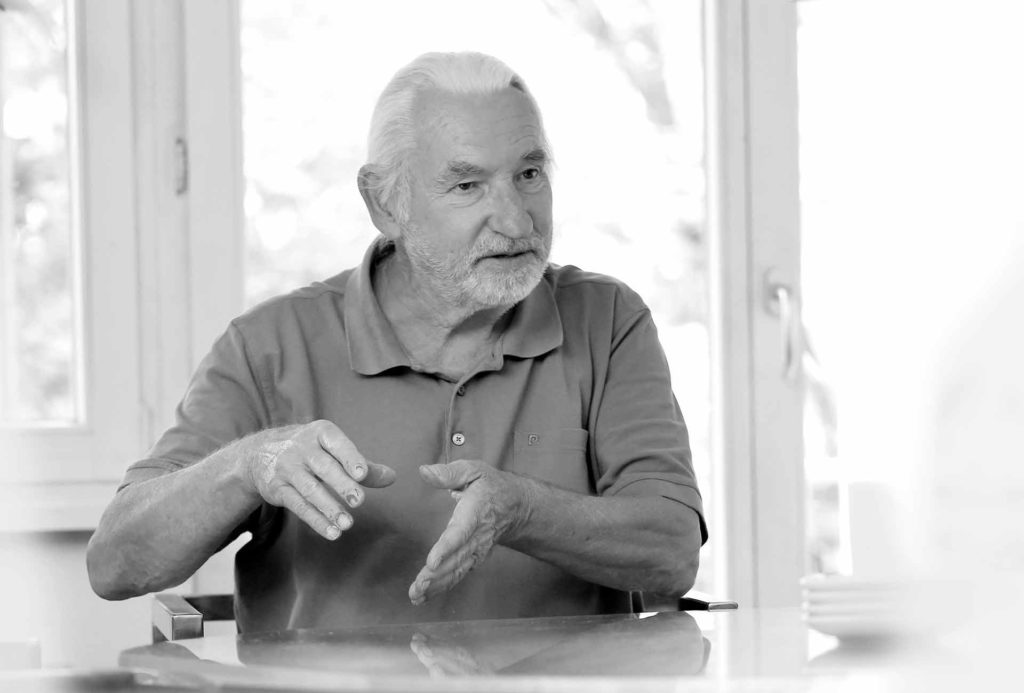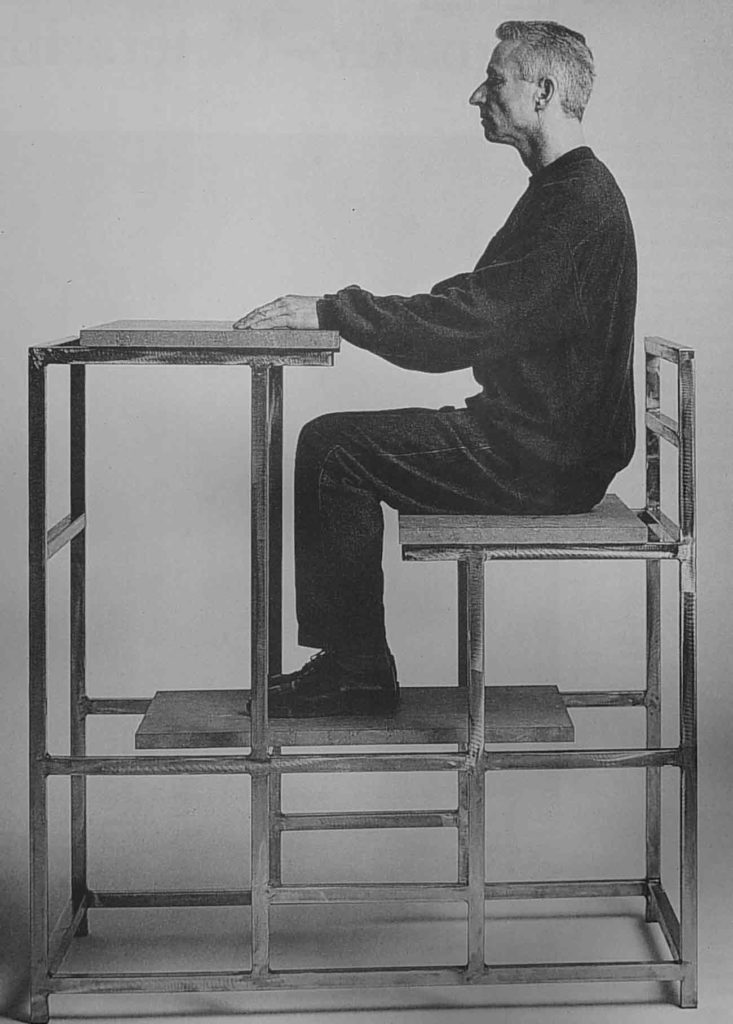
Neues deutsches Design is history. For the furniture artist Christoph Siebrasse, conscious, sensible sitting is still an important topic
The furniture and lamps of “Neues deutsches Design” [New German Design] had been a counter concept to “Die Gute Form” [The Good Form] à la Max Bill, which was considered dogmatic in the 1980s. Neues deutsches Design was also seen as a German response to Italian Postmodernism, Studio Alchimia and Memphis. Christoph R. Siebrasse and Rainer Schenk were part of the movement which is now a bygone chapter in design history. But both have continued until today.
An article entitled “How Much Avant-garde Is (Still) Allowed?” ran in the 3-1993 edition of “Art Aurea”. A full-page photo showed the furniture artist Christoph R. Siebrasse seated in his “Freidenker” [free thinker]. The construction of square steel recalls antique school desks, but could also be interpreted as a minimalistic sculpture and used as a lectern. The steel construction has three marble slabs: the lower slab is a footrest at a height of circa 50 cm; the middle slab is a seat; and the upper slab is a small work surface. Siebrasse is shown seated, his palms resting on the table surface and his spine vertical. His posture and his construction form a unity. The furniture artist shows what the Freidenker encourages: conscious, palpable sitting; concentrated work; and meditation.
Manfred Schneckenburger described the concept for a 1996 exhibit: “The humanist Siebrasse has recognized an important fact: living at home, belonging to a space, sitting and lying must be actively interpreted and actively lived. He enlivens these activities with tension and contemplation, movement and rest, individuality and stimulation. Refusing to allow us the all-too-comfortable self-flattery of ergonomically streamlined shapes that conform to the human anatomy, he understands ergonomics not as total conformity, but as a precise appeal to bodily experience. He provokes this physical experience – and is willing to pay the price that resistance at our lowermost vertebra reminds us of our spine’s physical presence.”

Christoph R. Siebrasse on his Freidenker [Freethinker]. Images of this kind established the legendary reputation of Neues Deutsches Design [New German Design]
Galerie “formformsuche” dedicated a two-man show to Christoph R. Siebrasse and Rainer Schenk during the IMM Cologne and the “Passagen” in 2018. The spectrum of forms between “Sensilla” and “Rosie” could hardly be wider. Allusions to Donald Judd, Joseph Beuys and Pop Art are obvious. “Siebrasse and Schenk have never clung to a single style,” the gallerist Martin Bohn explains. One furniture artwork, created after the fall of the Berlin Wall in 1989, is not included in the exhibit: Rainer Schenk’s painted “Einheitsschrank” [Unity cabinet] is missing. Its right-hand, somewhat smaller, sliding door signifies eastern Germany; its larger left-hand door symbolizes the western part of the country. Felt-covered seats flank it at the left and the right. “It took only two weeks to make because we definitely wanted to show it at the furniture fair in 1990,” Siebrasse recalls. “That cabinet sparked many discussions. Some West German visitors felt that the doors ought to be slid somewhat farther apart again.”
Siebrasse and Schenk lived in the diplomatic district of Bad Godesberg at that time. Their landlord, who belonged to the Christian Democratic Union of Germany, thought the cabinet should be given to Helmut Kohl because he is Germany’s “chancellor of reunification.” Siebrasse and Schenk made an exposé of the cabinet, which was given to Kohl’s assistent Juliane Weber. The artists were assigned a date to install the Einheitsschrank [unity cabinet] in the hallway of the chancellery. Kohl was notified: he came through a door and, as he turned away again, muttered, “I don’t like it!” Two years later, Dr. Rolf Köster, who is a friend of Siebrasse and Schenk, had the idea of giving the Einheitsschrank to former Foreign Minister Hans-Dietrich Genscher. It was shown at a New Year’s reception of the Free Democratic Party in Wuppertal. Genscher examined the cabinet and said: “It’s a handsome piece, but how could I convince my wife? We already have a cabinet in our living room.” Köster declared at the same exhibit: “Enough is enough. Now I’ll take it.”
Siebrasse made his first chair at age 16. “I was enthusiastic about crafting furniture objects for myself and others,” he says. Congenital blindness in one eye made it impossible for him to begin a conventional cabinetmaker’s apprenticeship, but family connections enabled him to get a relevant education. Siebrasse first met his partner Rainer Schenk at age 19, when Schenk was painting portraits of pop stars for LP record covers. Schenk recalls his partner’s advice: “If you want to become a painter and not merely an illustrator, I could introduce you to some artists.” Siebrasse’s older brother Michael owned a gallery and was an initiator of “Neumarkt der Künste” [“New Market of the Arts”]. Founded in 1969, the exhibition evolved into Art Cologne. Michael Siebrasse was a friend of Joseph Beuys and Emil Schumacher. “Through those meetings, I learned what I do and who I am today,” Schenk affirms.

The cantilever chair Sensilla in wenge wood with nautical textile ropes, 2017, produced by the manufacturer and cabinet maker Weingarten, Kerpen
In 1986, Siebrasse and Schenk cofounded the “Confrontation – Art & Design” group and started the “Avant-garde Design Center” at the Cologne International Furniture Fair, where they first showed their furniture. The term “Neues deutsches Design [New German Design] which was invented by the group “Kunstflug” and the historian of architecture and design Christian Borngräber (1945–1992), did not yet exist. The first design galleries opened in the late 1980s and showed artistically designed furniture objects and small series by groups such as Ginbande, Kunstflug and Pentagon. Circa 150 specimens of Siebrasse’s free-swinging “Sensilla” have been made to the present day.
Mostly manual fabrication in one’s own atelier was a trait of Neues Deutsches Design and is also why Manfred Schneckenburger described Siebrasse and Schenk not as designers, but as furniture artists. Schneckenburger wrote about manual fabrication in 1996: “… behind it is not a faithful denomination to homemade, but a simple necessity. No other impetus could account for the invention of these haptic utilitarian objects.” Today too, Siebrasse and Schenk continue to do most of the work with their own hands. “The objects that can be bought at Markanto are either made by us in our little workshop or at the Weingarten carpentry and furniture manufactory in Kerpen. There too, we make the prototype in one-to-one format.” Christoph R. Siebrasse and Rainer Schenk are now 75 and 68 years old, but have never lost their passion for making furniture and art. They also share a passion for vintage cars… but that’s another story.
Portrait photo: Eric Jobs Text: Reinhold Ludwig